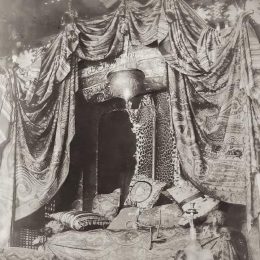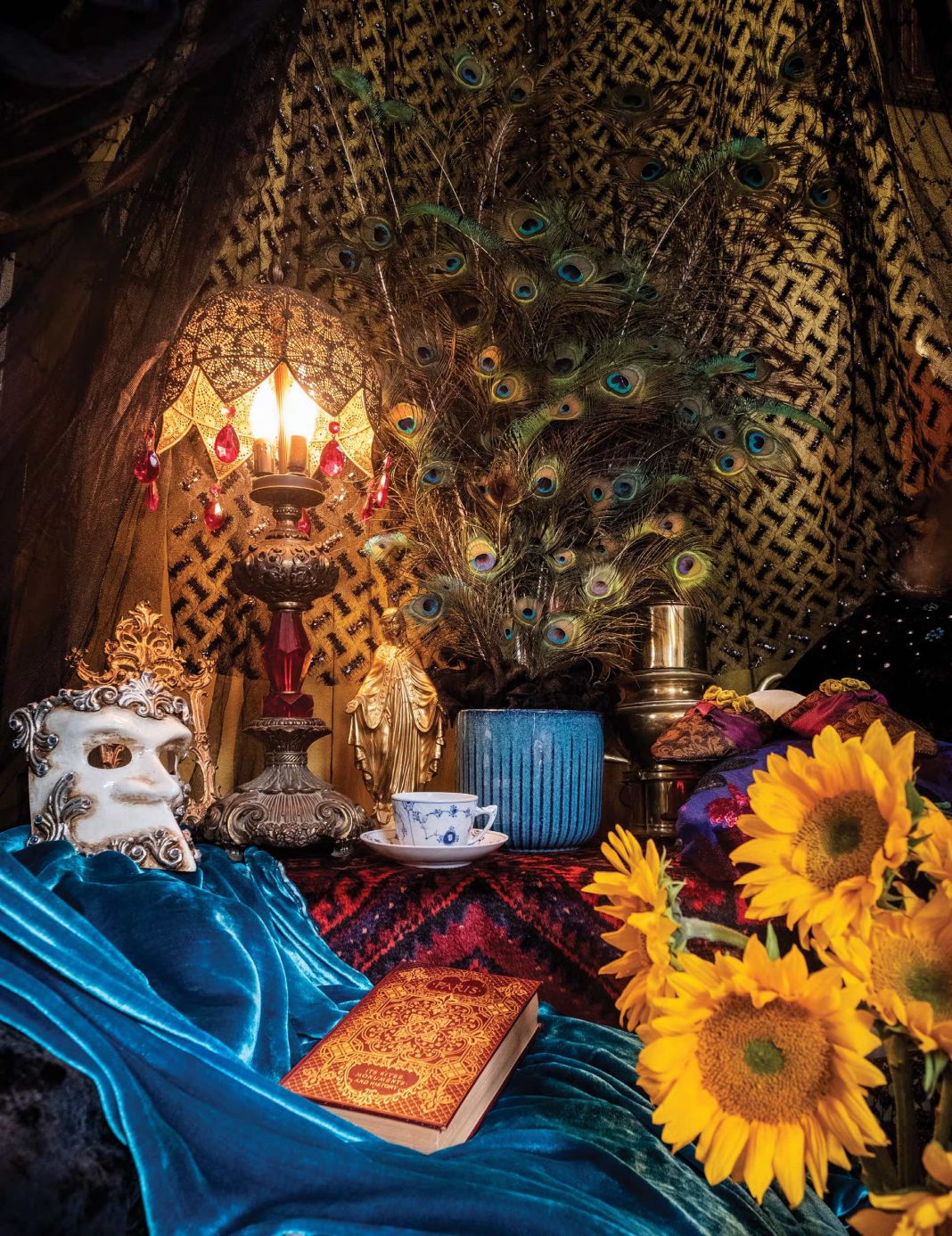Photograph by STEVE PARKE

A beautiful room is like a long, luscious drink of whatever restores you. Your home should both delight your body and spark your imagination—it brings you pleasure in the moment, plus inspiration that reaches beyond the walls and into the dreamy world of art.
If your taste is decadent, the drink is absinthe and the room is all about lush textures and foreign lands. Back in the day, walking through a decadent’s home was like taking a world tour. Aesthetes and artists particularly leaned toward home decor that evoked other cultures, particularly those of Asia and the Middle East. If they traveled, they collected decorative objects from every stop on their journeys; if they couldn’t go abroad themselves, they bought what was available locally. In Oscar Wilde’s rooms at Oxford, for example, an abundance of blue-and-white Chinese vases (holding towering sunflower bouquets) helped define the aesthetic which Wilde would tout in his often-presented lecture “The House Beautiful.” In his 1885 London drawing room, the glint of black lacquer evoked Japan, and a window’s unattractive view was covered with a panel of wood pierced and carved in a copy of a pattern seen in Cairo. His son, Vivyan Holland, noted that walls were peculiarly covered in a William Morris paper. But we’re talking about the divine Oscar; in our eyes, his choices were never wrong. To wit: The ceiling was designed by Whistler and inlaid with peacock feathers—another of Wilde’s signature touches.
Turkey, Algeria, Morocco, and the Moorish-designed Alhambra were big sources of inspiration for all Aesthetes. Painter Jean-Joseph Benjamin-Constant filled his studio with what Shirley Fox, one frequent visitor, described as “a choice collection of Moorish rugs and curtains and ornaments of all sorts”—all mixed with suits of armor and comfy easy chairs, hanging lanterns, Syrian tables, and brass vases. Fox wrote that he “had transformed the place into quite a suggestion of the Alhambra itself.” Another artist, Anna Alma-Tadema, painted on canvas the “Gold Room” in her famous father’s house; that room was lacquered and gilded within an inch of its creator’s life, hung with brocade silk curtains, furnished with a long, low blue divan—an expansive version of the prim European settee—and finished off with an enormous bird cage suspended from a mosaic ceiling.
Of course, not everyone had access to rooms on such a large scale, or budgets to match. But even the most averagely middle-class home or grotty Bohemian hideaway had the means to establish that most distinctively fin de siècle element of decor, the cozy corner.
In the Victorian era, when every parlor was overstuffed, there likely wasn’t much room for a divan (and it would have been rather scandalous if the average person had added one). But for a cozy corner, all you needed, yes, was a corner—and some fabric with which to make it a curtained space apart. Carpets were important, if you had them. You might hang a Turkish rug on a wall like a tapestry or drape one over an ottoman or table. Whether or not you were fond of Wilde, you probably set out blue-and-white china, peacock feathers, and fresh flowers in season (beaded or silk ones in winter). Brass candlesticks gleamed everywhere, and so did scraps of brocade and velvet from which you could cover cushion after cushion after cushion—because the goal of a cozy corner was to bury yourself in the textures, the glints of metal and mother-of-pearl, perhaps a whiff of perfume or even (gasp!) imported incense. A modern decadent can make their own cozy corner in less than a day, on virtually any budget. See the example at right, from my own lair. Thrift stores, flea markets, import shops, and even online behemoths can provide what you’ll need. Perhaps start by hooking up some mosquito netting, now trendy for wedding tents and bed canopies; you’ll create an instant sense of separate, specialized space. You can also use the set’s hoop and hooks for heavier fabric of your own choice—an assortment of silks, rayon challis, satin, jacquard. Moroccan-inspired lamps can be found at any import store (and that includes online retailers); you’ll enjoy scouring estate sales and thrift stores for brass trays and coffee sets, maybe an old silver tea service. You might even find a prize inlaid box or table to add. And feathers! You are, after all, a proud peacock feathering your nest.
Traditional colors and fabrics are the reds and blues of antique carpets, the cobalt and white of old china, the turquoise of Turkish tiles, the black of ebony and lacquer. But this is your sanctuary—if you like pink chintz and sequins, do your corner in pink chintz and sequins! Bring in that glorious elephant statue you inherited from your granny; hang up that painting of Klimt’s Kiss. If you prefer apple juice to absinthe, well, we encourage healthy choices, and it will look just as gorgeous in your glassware.
Lighting is easy to regulate now. If you don’t want real candles burning amid all that lush fabric, inexpensive LED tea lights or strings of fairy lights will do the trick, casting luscious colors and intriguing webs of shadow over your sanctum sanctorum. You can even fill a colored goblet with tiny balloon lights for a small, glowing surprise.
This is your private space for dreams. If you close your curtain, no one else needs to see. In the end, decadence is whatever makes you happy, whatever restores you, whatever sends your imagination on new flights of fancy.


































